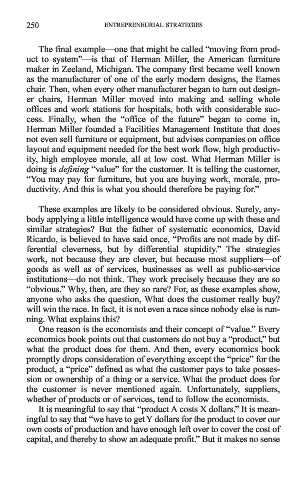Page 257 - ENTREPRENEURSHIP Innovation and entrepreneurship
P. 257
53231_Innovation and Entrepreneurship.qxd 11/8/2002 10:50 AM Page 250
250 ENTREPRENEURIAL STRATEGIES
The final example—one that might be called “moving from prod-
uct to system”—is that of Herman Miller, the American furniture
maker in Zeeland, Michigan. The company first became well known
as the manufacturer of one of the early modern designs, the Eames
chair. Then, when every other manufacturer began to turn out design-
er chairs, Herman Miller moved into making and selling whole
offices and work stations for hospitals, both with considerable suc-
cess. Finally, when the “office of the future” began to come in,
Herman Miller founded a Facilities Management Institute that does
not even sell furniture or equipment, but advises companies on office
layout and equipment needed for the best work flow, high productiv-
ity, high employee morale, all at low cost. What Herman Miller is
doing is defining “value” for the customer. It is telling the customer,
“You may pay for furniture, but you are buying work, morale, pro-
ductivity. And this is what you should therefore be paying for.”
These examples are likely to be considered obvious. Surely, any-
body applying a little intelligence would have come up with these and
similar strategies? But the father of systematic economics, David
Ricardo, is believed to have said once, “Profits are not made by dif-
ferential cleverness, but by differential stupidity.” The strategies
work, not because they are clever, but because most suppliers—of
goods as well as of services, businesses as well as public-service
institutions—do not think. They work precisely because they are so
“obvious.” Why, then, are they so rare? For, as these examples show,
anyone who asks the question, What does the customer really buy?
will win the race. In fact, it is not even a race since nobody else is run-
ning. What explains this?
One reason is the economists and their concept of “value.” Every
economics book points out that customers do not buy a “product,” but
what the product does for them. And then, every economics book
promptly drops consideration of everything except the “price” for the
product, a “price” defined as what the customer pays to take posses-
sion or ownership of a thing or a service. What the product does for
the customer is never mentioned again. Unfortunately, suppliers,
whether of products or of services, tend to follow the economists.
It is meaningful to say that “product A costs X dollars.” It is mean-
ingful to say that “we have to get Y dollars for the product to cover our
own costs of production and have enough left over to cover the cost of
capital, and thereby to show an adequate profit.” But it makes no sense

